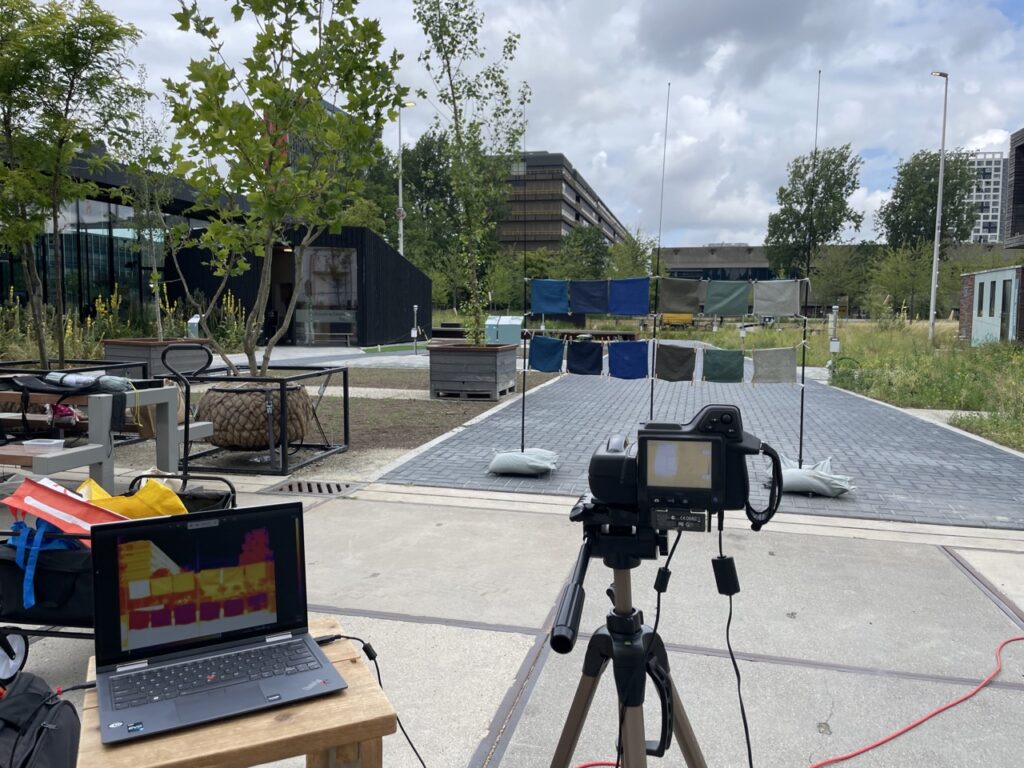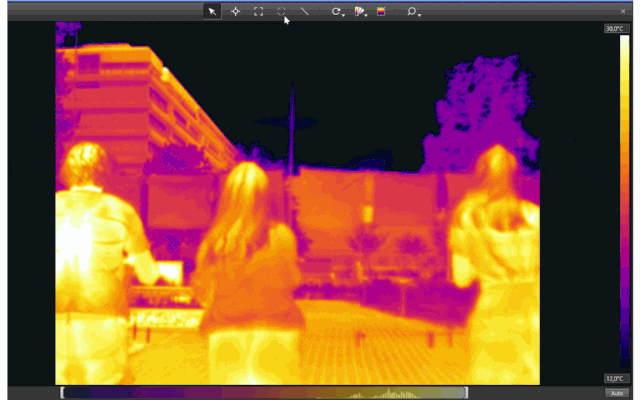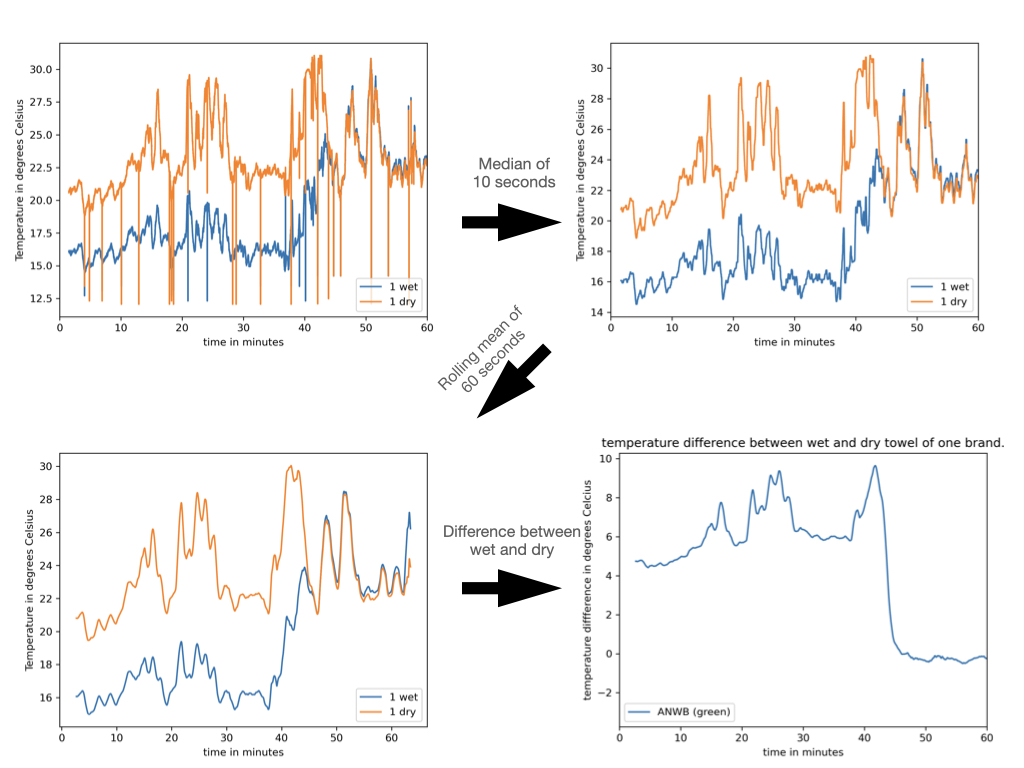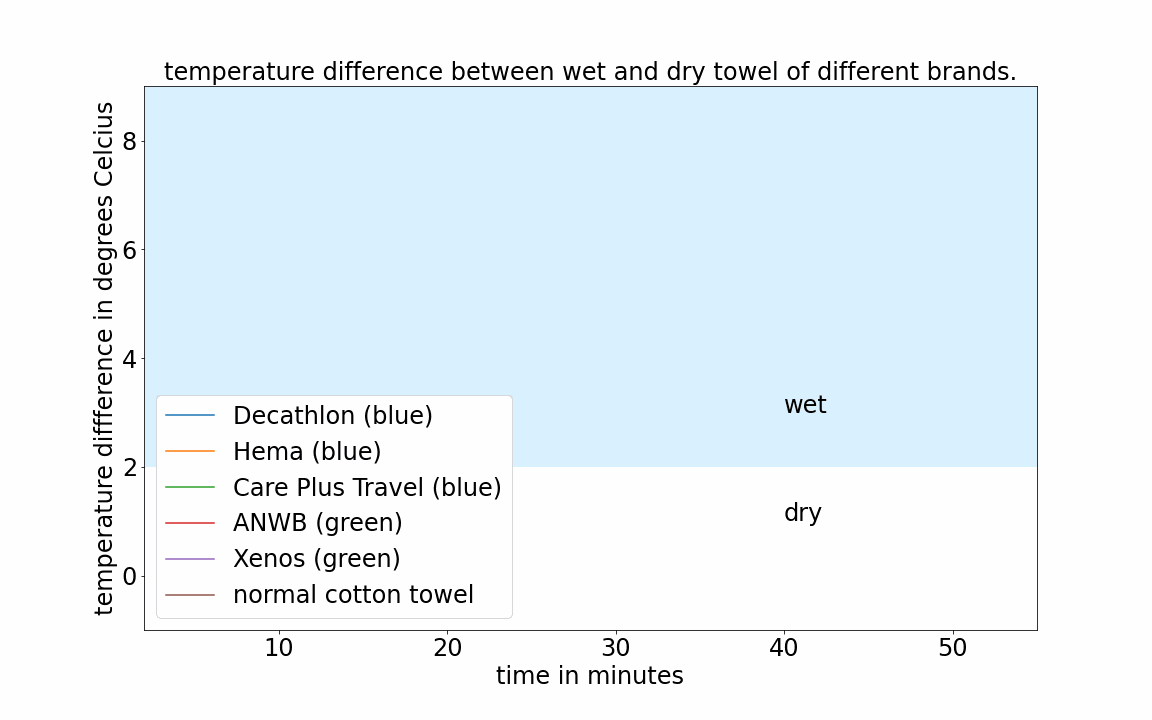“Do fast-drying-towels actually dry faster? Can you build us a measurement setup to test this?”
I was delighted when the crew of TV show "Kassa" asked me that question: partially because I think it can clearly showcase how science works and partially because I was really looking forward to doing experiments again after doing a whole lot of data (and software) science lately.
The experimental setup (how do we plan to measure?)
Having done science communication on television before, I was positively surprised how meticulously the crew of Kassa approached the experiment. Since they are going to make a claim on tv on which brand of towel is fastest in drying, they rightfully wanted to be sure that the experimental method used to come to the conclusion was sound. We took about three iterations in drafting an “experimental protocol” detailing exactly how we would be doing the experiment.
We quickly discarded the idea of continuously weighing the towels. We wanted a ‘realistic’ setup, so having towels in the wind, on a washline, outside: as close as possible to how people normally dry towels. Having to take them down every minute and weigh them would introduce a lot of errors in taking them down and putting them up again. Having them hanging from strain gauges (weight measurement sensors) would also not work because the noise due to the forces of the turbulent wind pulling on them would be too high.
Since evaporating water cools its surrounding, a drying towel should be cooler than a similar towel exposed to similar wind and temperature conditions. If we would hang a wet towel just under a dry towel of the same brand and tracked the temperature difference between the two, we could conclude that the wet one had completely dried when the temperature difference between them disappeared: no more water left to evaporate and thus no more cooling. A quick back of the envelope estimation showed that this effect should be several degrees Celsius, so something that a thermal (infrared) camera should be able to pick up. I knew that colleague Martin Tenpierik from the faculty of Architecture has a high-end thermal camera he uses to study heat dissipation from buildings! Furthermore, ‘the green village’, a ‘field lab for sustainable innovation’ on our campus would be the ideal location to setup a clothesline with towels and measure how fast they dry. For the final measurement setup we settled on:
- 5 different brands of “fast drying towels” will be compared, plus one classic cotton towel as control.
- All towels are cut to be identical in size (25 x 25 cm)
- We have two towels per brand: one that will be made wet and one that is dry throughout the experiment as a control.
- Build a clothesline system where the two towels of the same brand can be hung directly above each other so they will experience the same outside temperature and wind conditions.
- All towels to be wetted are wetted with the same amount of water (25 ml) using a (high precision, 0.1 g) kitchen scale.
- Wetted towels are stored in a sealed container in between the (short!) time of wetting and putting them on the clothesline to minimize evaporation losses during that time
- All towels are put on the clothesline at the same time (teamwork, all within one minute)
- A 640 x 480 pixels resolution thermal camera from FLIR is placed on a tripod 5 meters from the clothesline, with all towels in the frame.
- The Camera doesn’t store temperature video information directly, so using a laptop connected over USB to the camera, the measurement of the camera will real time be displayed on the laptop screen. Using screen capture software this will be recorded, creating a video of the entire experiment.
- The experiment will be repeated at least three times, with a different ordering of the different brands, to make sure that things like “edge effect” do not influence the conclusions overall.

A photo of the measurement setup with the thermal camera in the centre of the image. The temperature difference of the towels can clearly be seen on the laptop screen: the wet towels in the lower row are much colder than the towels in the upper row. Data analysis (how did we determine which brand dried fastest)
The output of the experiment was four rather large mp4 video files containing the measurements from the thermal camera. During the experiment we could already clearly see that some towels were drying faster than others, but this had to be established numerically of course!

A timelapse made from the 4.5 GB of movie recorded with the thermal camera. The lower row of wet towels start at a lower temperature and one by one you can see them dry and reach the temperature of the upper row of dry towels. The hardest part of the data analyses was to determine how color in the video from the thermal camera related to temperature of the object. Luckily a temperature scale was displayed in the window as well. I programmed a piece of software that identifies where in the image the temperature scale is located and make a mapping from color to temperature. Then, for each frame of the video, for each towel, I determined the average (Red, Green and Blue) values of the pixels that captured the towel and used my mapping to determine the temperature. This resulted in a temperature record over the length of the experiments. However, a few times the screensaver of the laptop turned on and a few times people walked in front of the camera. These can clearly be seen in the temperature data as spikes. I filtered these out by taking a ‘rolling median’ with a ten second window. This means that in ten seconds of temperature data, I look for the median value and attribute that to the center of the window. In the filtered data I could clearly see the difference between the wet and the dry towel and also that both towels would go up or down in temperature at the same moments when for example the sun came out from behind the clouds. To make sure these variations did not interfere with determining the exact moment when I considered both temperature to be equal (and thus the wet towel to have dried), I applied a minute long moving average. Finally, I substracted the temperature of the wet towel from the dry towel. By determining when this difference becomes zero, I can determine when a wet towel has completely dried. See the figure below for the impact of the filtering step on the results.

The steps of the data analysis: the raw temperature data is filtered first by taking a rolling median to filter out errors due to for example the screen saver of the laptop turning on. Subsequently I use a 1 minute rolling average to smooth out temperature fluctuations due to clouds passing by. Finally I take the difference between the wet and dry towel to identify when the wet towel has dried: the moment the temperature difference disappears. Finally, I’ve made a gif that shows as a little movie the results for all brands, so you can clearly see which brand has dried first by looking at which brand drops to zero temperature difference first.
All the code I wrote, including explanation on the physics involved, I have shared openly on GitHub. If you want to tinker with the analyses, make different plots, or use some of my code, feel free to do so. If you want to build on my code, please use the citation information found on zenodo:
Results and conclusion (so which brand dried fastest?)
As the gif below shows, the towel from Care Plus Travel is the first one to dry up: about 30 minutes into the experiment the temperature difference of this brand suddenly drops from around 5 degrees Celsius to around zero degrees. A few minutes later, around 36 minutes into the experiment, the towel from Decathlon follows suit. The other three fast drying towels take about the same time to dry, roughly 45 minutes into the experiment. The sharp decline for all these towels tells me that cooling (in amount of water per time) is very constant until all the water is gone, and then suddenly the temperature of the wet towel rises to meet that of the already dry one. The classic cotton towel shows a different behavior: the temperature of the wet towel slowly moves closer to that of the dry towel. This can be explained by what we saw on the thermal camera: the cotton towel dried in spots first before drying completely. The other towels dried all over.

The results shown in a moving graph. When the line drops to around zero degrees difference between the wet and the dry towel I conclude that at that point the dry towel has completely dried up. The repeat experiments show similar results: out of four experiments the Care Plus Travel towel dried fastest three times and the Decathlon a close second. In one of the four experiments the Decathlon dried fastest with the Care Plus a close second. In all experiments the other three towels took about equally long to dry.
The difference in drying time between the different brands of ‘fast drying towel’ is scientifically significant. This means that when looking at the uncertainties in our measurements I am very sure that the difference we see between drying time of the towels is due to the difference between the towels and not due to randomness in the way we setup our experiment. However, we also have to judge if the differences are relevant. Is a five minute faster dry-time relevant considering it takes about 35 minutes to dry the towel? Or maybe zooming out even further: are those five minutes relevant on a three week camping trip?
Discussion (what are the limitations of our experiment?)
There are, of course, always choices in our experimental setup that could have been made differently and that will influence our results. For example, in our experiment we tried to stick as close as possible to a situation ‘as normal’, while at the same time trying to have everything as equal as possible. That is why we decided to use an equal amount of water (25ml per towel) for each towel. It could be argued that must campers will wring as much moisture out of a towel as possible before hanging them to dry. Different towels would have different amounts of water still in them after wringing and this would potentially lead to other results than ours. We decided on using equal amount of water for each towel because we focus on the claim of fast-drying, not on the claim of “maximum wring-abililty”. Furthermore, we did our experiments on one day. The weather was nice, around 20 degrees Celcius and a nice breeze. So technically we can only claim that we measured which towel dries fastest in these weather conditions. The amount of drying depends on both how easy wind can flow through a towel as well as the temperature of the towel itself, which depends among other things on the color. So technically on a very hot day with no wind, another towel from our set may dry faster than the one we picked as fastest under our conditions. My hypothesis would be that even under different weather conditions the towels would dry in the same order (but not in the same time!)
Finally, we have to acknowledge that in this experiment we only looked at how long it takes to dry these towels and that other questions might be more important. All towels branded as ‘fast drying’ are made out of plastics (often recycled PET). These towels shed a lot of plastic microfibers into the environment when drying on a clothesline. The fibers that cotton towels shed are biodegradable over much shorter timelines than those plastics that accumulate in the environment. Whether that is worth a five minute faster drying time is left to your own values, but personally I tend to rather buy cotton towels and wait a little longer. And when I do, I think I will read a book and enjoy the scenery instead of looking at towels through a thermal camera.
- Blogs (163)
- Digitale data en economie (19)
- Geek en/of nerd (35)
- Onderwijs en politiek (40)
- Overig (34)
- Tinkering (knutselen) (71)
- Energie overdenkingen (1)
- English (39)
- forwardingPages (6)
- In de media (70)
- Huts Koffer, Volkskrant (36)
- overige media optredens (20)
- Radio 1: nieuws en co (12)
- Nieuws (168)
- Terugluisteren (8)
- Wetenschap (45)
- andermans werk (5)
- eigen werk (35)
- Blogs (163)